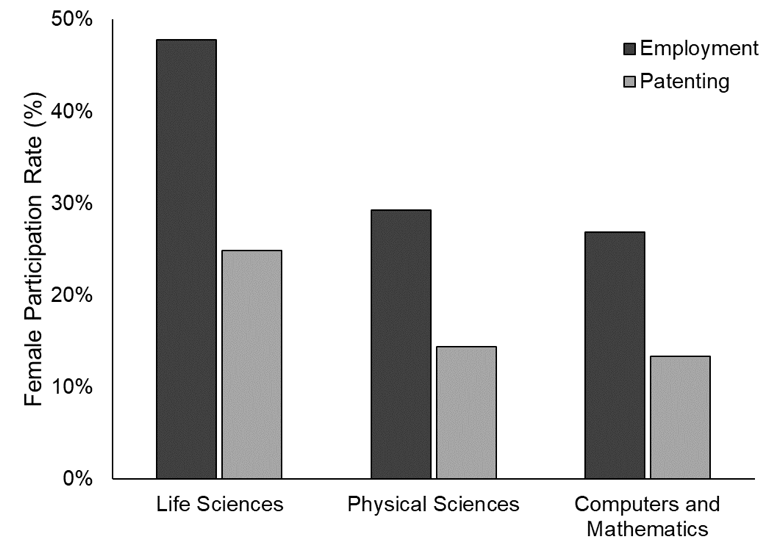“It is essential to investigate these root causes…. If we can promote full support of female engineers and scientists in industry and the patenting process, the number and breadth of discoveries will increase and society will benefit.”
 The Study of Underrepresented Classes Chasing Engineering and Science Success (SUCCESS) Act of 2018 directs the U.S. Patent and Trademark Office (USPTO) to study and report to Congress on the number of patents applied for and obtained: (1) by women, minorities, and veterans; and (2) by small businesses owned by women, minorities, and veterans. In partial fulfilment of that directive, the USPTO Office of the Chief Economist, in February of 2019, published “Progress and Potential – A profile of women inventors on U.S. Patents”. The stated purpose of the report is “to learn more about the progress and potential of women in patenting,” as a means to “harness underexploited talent.”
The Study of Underrepresented Classes Chasing Engineering and Science Success (SUCCESS) Act of 2018 directs the U.S. Patent and Trademark Office (USPTO) to study and report to Congress on the number of patents applied for and obtained: (1) by women, minorities, and veterans; and (2) by small businesses owned by women, minorities, and veterans. In partial fulfilment of that directive, the USPTO Office of the Chief Economist, in February of 2019, published “Progress and Potential – A profile of women inventors on U.S. Patents”. The stated purpose of the report is “to learn more about the progress and potential of women in patenting,” as a means to “harness underexploited talent.”
Among other areas of investigation, the report presents estimates of female participation in diverse fields relevant to patenting, such as life sciences, engineering, natural sciences, computer and math sciences, etc. In comparing the results to an estimate of female inventor rate (determined by textual analysis of inventor names) the report concludes that female participation in the workplace has outpaced the development of female inventorship. Additional data reflect elevated participation by women in team projects relative to individual efforts, and geographic concentration of female inventors in regions of high female employment, such as California and the Northeastern States.
Importantly, while the agency has summarized a variety of studies attempting to characterize a degree to which women participate in the patenting process, the agency notes that this type of data is scarce (and is even more scarce when considering underrepresented minorities and veterans). This creates a sizable challenge because, in addition to the responsibility to collect and report these data, the SUCCESS Act tasks the USPTO to promote participation of underrepresented demographics in the patenting process. A standard approach for developing recommendations to achieve a particular result is to identify strategies that were used (e.g., by particular entities and/or in particular contexts) that successfully led to the desired result. To this end, we believed that it may be instructive to attempt to pair women-inventor-representation data and women-workforce-representation data across multiple technological fields. Potentially the ratio of women’s inventor representation over workforce representation is higher for a subset of fields. If so, practices and/or customs of the select field(s) may be identified and potentially recommended for other fields.
Methods
We requested and received data from the World Intellectual Property Organization (WIPO) that identified a count of all inventors and a count of female inventors across patent applications naming the United States as the reporting office. The data was parsed by publication year and technology area.
We further used workforce data from the National Science Foundation (NSF) Science and Engineering Indicators that identified, for each of multiple years, the percentage of employees in various industries that were women. The industries represented in the NSF data included the Life Sciences; Computer Sciences and Mathematics; and Physical Sciences.
There were 35 technology areas represented in the WIPO data. To perform a side-by-side comparison between the workforce and inventor data, for each of the workforce-data industries, we identified a subset of the WIPO technology areas as corresponding to the industry. Specifically, the technology areas defined to correspond to each of the three NSF workforce industries were:
- Life Sciences: Biotechnology, Pharmaceuticals, Organic Fine Chemistry, Macromolecular Chemistry, and Analysis of Biological Materials
- Computer Sciences and Mathematics: Computer Technology, IT Methods for Management, and Basic Communication Processes
- Physical Sciences: Optics, Telecommunications, and Semiconductors
We calculated women inventor rates as the percentage of all inventors listed on patent applications (for a given publication year and in a given set of technology areas) who were estimated (based on an automated name analysis performed by WIPO) as being a woman. Thus, if a data set represented two patent applications – a first listing 3 male inventors and 1 female inventor and a second listing 1 male inventor – the woman inventor rate for the data set would be 20% (1 female inventor listing divided by 5 total inventor listings).
The most recent workforce data in the NSF data set pertained to 2017. Thus, we used inventor-rate data from year 2017 as well for our data comparisons.
Results
Figure 1 shows the extent to which women were represented in various U.S. workforces in 2017 (based on the NSF data) and the extent to which women were represented in inventor lists on PCT patent applications filed using the U.S. receiving office in 2017. The representation of women in the workplace and as inventors varies across industries. More specifically, the percentage of scientists in the workplace who are female is higher for life-science industries (48%) as compared to physical-science (29%) and computer industries (27%), and further, the percentage of inventors who are female is also higher for life-science industry (29%) as compared to physical-science (14%) and computer (13%) industries. However, despite this correlation, the female participation rate with respect to patenting was substantially lower as compared to the female participation rate with respect to employment.
Figure 2 shows the ratio of the female inventor rate relative to the female employment rate per industry. Notably, despite sizeable differences in the absolute female participation rates in Figure 1, this ratio is remarkably consistent across industries (Life Sciences: 52%; Physical Sciences: 49%; Computer and Mathematics: $50%). Thus, this data indicates that, across industries, employed female engineers are half as likely to be listed as inventors on patent applications as compared to their male counterparts.
Figure 2
Discussion
The authors had initially hypothesized that the proportion of inventors who were female would be higher in industries in which a larger portion of the scientists and engineers were female. For example, given that the portion of scientists/engineers that are women is higher in the life sciences is higher as compared to (for example) physics and/or computers, the authors had hypothesized that the female inventor rate would be higher in life-science industries as compared to physics and computer industries. Such a result may have been due to (for example) differences in institutional structures implemented in organizations and/or different genders of decision-makers (e.g., supervising scientists and/or making patenting decisions) that were male-dominant versus rather gender equal. Interestingly, the above-presented data runs contrary to our hypotheses.
Why might females be underrepresented as inventors, even within industries where many females are employed? Potentially, this underrepresentation may be explained by a difference in the types of occupational positions of males as compared to females. For example, the male-female discrepancy may be at least partly explained if male scientists are more likely to be employed in positions in which discoveries are more likely to be made and/or innovations are more likely to be prioritized. Another possibility is that, across industries, females face similar impediments to facilitating patenting of a discovery (and/or pursuing being listing as an inventor on a patent application). For example, females are statistically more likely to be part of a dual-income household as compared to males, so they may (on average) have less time to engage in the patenting process.
The authors submit that it is essential to investigate these root causes. It would be highly valuable to collect controlled data that indicates, for a given industry and a given position, the likelihood that an invention lists a female inventor as compared to a male inventor. If there is a discrepancy (which the above data suggests that there may be), engagement with companies and inventors may provide insightful information as to why these discrepancies these exist and techniques that may be employed to reduce or eliminate them. If we can promote full support of female engineers and scientists in industry and the patenting process, the number and breadth of discoveries will increase and society will benefit.
Conclusions
The SUCCESS Act has tasked the USPTO and the Small Business Association with identifying strategies for promoting participation of under-represented groups in the patent system. Substantial progress has been made over the years in terms of representing women in the workforce. Further, there has been a sizable increase in the female inventor rate. However, the female inventor rate remains low. An initial hypothesis may have been that low female inventor rates are a result of low employment rates of women in STEM industries. However, our data indicates that the discrepancy between the female inventor rate and the female employment rate is remarkably consistent across industries. The authors submit that patent applicants hold data that may allow for more controlled and detailed data assessments to be performed that would facilitate understanding as to why this discrepancy exists and what approaches may successfully promote participation of under-represented groups in innovation and the patent system.

![[IPWatchdog Logo]](https://ipwatchdog.com/wp-content/themes/IPWatchdog%20-%202023/assets/images/temp/logo-small@2x.png)




![[Advertisement]](https://ipwatchdog.com/wp-content/uploads/2024/04/Artificial-Intelligence-2024-REPLAY-sidebar-700x500-corrected.jpg)
![[Advertisement]](https://ipwatchdog.com/wp-content/uploads/2024/04/Patent-Litigation-Masters-2024-sidebar-700x500-1.jpg)

![[Advertisement]](https://ipwatchdog.com/wp-content/uploads/2021/12/WEBINAR-336-x-280-px.png)
![[Advertisement]](https://ipwatchdog.com/wp-content/uploads/2021/12/2021-Patent-Practice-on-Demand-recorded-Feb-2021-336-x-280.jpg)
![[Advertisement]](https://ipwatchdog.com/wp-content/uploads/2021/12/Ad-4-The-Invent-Patent-System™.png)






Join the Discussion
8 comments so far.
Anon
April 21, 2020 06:32 pmBravo Mr. Hardin.
Curious
April 21, 2020 12:18 pmThe numbers speak for themselves.
They still don’t say much. The methodology looks at patent applications — not patent grants. As such, the disparity happens before the patent application is ever filed. Therefore, this is a problem before it ever reaches the USPTO, and consequently, I’m not sure what the USPTO can do to increase participation.
A more sophisticated analysis would have looked at factors such as: (i) the relative experience of the individual inventors, and (ii) what positions within the field these inventors are working. I suspect longer-tenured inventors will likely have greater participation in the patent system, and if a larger percentage of woman are newer employees, that might explain some of the difference. Also, some of the difference can lie in the types of jobs in those particular fields. Someone in research is going to have a different IP participation rate than someone who is in product support.
This is the type of information needed to gain a better explanation of why there is a gap.
Curious
April 21, 2020 12:06 pmThe politically incorrect answer is that women are not as stupid as men, and the USPTO needs to improve their product if they want more women to buy it.
LOL. I must admit, that is about as good an explanations as I have read so far.
Eleanor Meltzer
April 21, 2020 10:16 amI reached out to co-author Kate Gaudry, who provided the following additional insight on the reason female inventor rates matter:
The 2017 male employment rates for life sciences, physical sciences, and computer sciences were 52%, 71%, and 73%, respectively.
The 2017 male inventor rates for life sciences, physical sciences, and computers were 75%, 86%, and 87%, respectively.
Thus, the male patenting participation relative to the male employment participation for life sciences, physical sciences, and computers were 144%, 121%, and 119%, respectively.
———————-
The numbers speak for themselves.
Jeff Hardin
April 21, 2020 06:35 amThe article says: “The authors submit that patent applicants hold data that may allow for more controlled and detailed data assessments to be performed that would facilitate understanding as to why this discrepancy exists and what approaches may successfully promote participation of under-represented groups in innovation and the patent system.”
True, patent applicants do hold this data. In fact, these very patent applicants testified to the USPTO in their SUCCESS Act study that the inability to enforce and defend a patent is a major deterrant to participating in the U.S. Patent System in the first place. In fact, 79% of them expressed this. Just read the public comments. These witnesses were not too pleased when they found out their testimonies were ignored by the USPTO in their report. Read this letter:
https://www.usinventor.org/wp-content/uploads/2020/01/Inventor-Letter-to-Rep-Velazquez-re-SUCCESS-Act.pdf
My wife and I testified, and I provided seven specific legislative recommendations for the USPTO to provide Congress as required by their SUCCESS study, but the USPTO instead said that commemorative stamps featuring inventors would increase the number of patents among the underrepresented. Seriously.
And then, there also is the concern that “would-be” patent applicants won’t even enter the arena due to the risk of defending a patent at the PTAB. So these inventors won’t even be “patent applicants”. Rather, they will be “left behind inventors.” This very concern was brought up by PPAC to the USPTO during the middle of their SUCCESS Act study in August 2019, and the USPTO didn’t know what to say, except, “we will ignore your question and say that we have pro bono assistance programs so underrepresented groups can get more patents” … patents that they ultimately can’t defend, which was the whole point of the question. That conversation is here: https://youtu.be/5QUhzCz8lfI
The USPTO is on record saying they would touch on this in their report, but they did not.
Nevertheless, the USPTO continues to sell to these underrepresented groups a false promise of a reliable patent grant, which will later be challenged at the PTAB, where skilled patent examiners who have already examined the patent will be undermined by unconstitutional and inexperienced judges who make a subjective opinion to invalidate it, as occurs to 84% of patents that are reviewed. Nevermind, to undergo such a patent challenge is at the expense of the inventor/patent holder at a staggering cost of at least $450K per the 2017 AIPLA report!
What smart, independent female or minority inventor would want to play this game? I’m a white male and I don’t.
Like many inventors are now realizing, China’s strong IP system will give me the protection I need. I really wish I were joking.
Concerned
April 21, 2020 05:34 amRight on Josh Malone regarding women are just plain smarter. The only stupid thing my wife has done was marry me.
Frankly, a person has to be half insane to pursue a patent with the decisions coming out of the courts. Those decisions seem to support the allegations of some posters that the judges were intentionally put in place to burn the patent system down.
Certainly in the prosecution of my patent logical thinking has been void and I’m just now headed to the PTAB. I think my examiners to this point are intelligent, it just seems that a hidden agenda is in play with the rejections that are being advanced.
I just cannot see my wife engaging in this kind of pursuit and folly.
Josh Malone
April 20, 2020 11:56 amSocial science has established that a greater proportion of men engage in risky behaviors such as substance abuse, heavy alcohol consumption, unprotected sexual intercourse, reckless driving, or extreme sports.
Trying to enforce a U.S. patent presents similar levels of risk.
Several women inventors raised this issue in their SUCCESS Act testimony, but they were excluded from the analysis and report to Congress.
The politically incorrect answer is that women are not as stupid as men, and the USPTO needs to improve their product if they want more women to buy it.
Pro Say
April 20, 2020 10:25 amThe Patent Office is to be congratulated for their excellent current and forthcoming resources, efforts, and initiatives to ensure that all inventors — regardless of gender, race, geographic locations, or economic standing — have full and equal opportunity and access to develop, protect, and commercialize their inventions.
That said, if and until such time that Congress and/or our Supreme Court restore full patentable eligibility to all inventions — regardless of the field of innovation — such opportunity and access will continue to be blocked; including for those most in need of American opportunity and access.
Including both America’s current — and her future — female inventors.